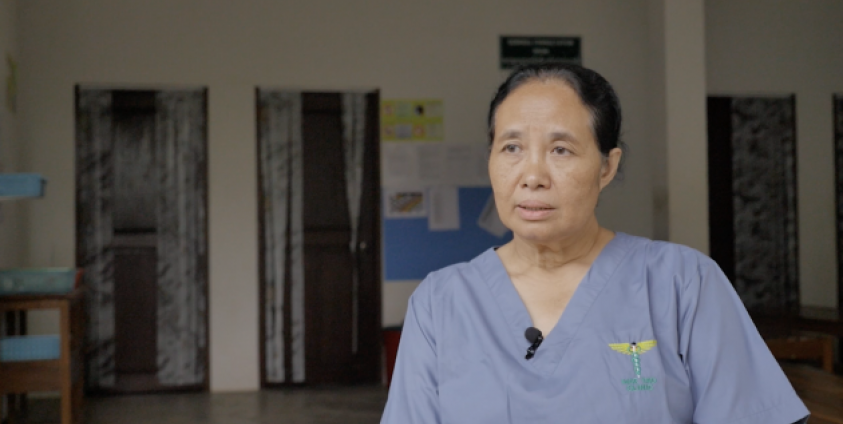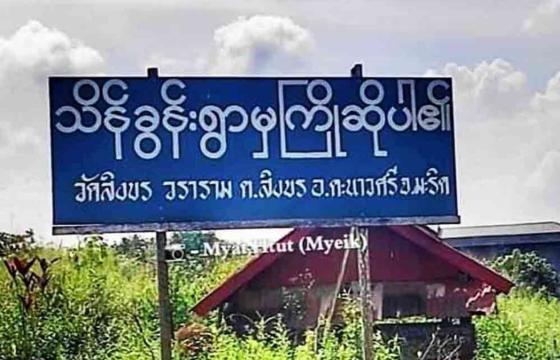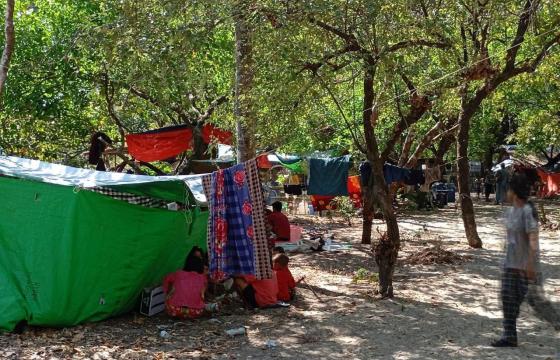Dr. Cynthia’s Mae Tao Clinic is struggling to keep helping patients as donors to the Thai-Burma border stop funding.
Mae Tao Clinic is appealing for help as funding cuts from donors are impacting their operations. The Clinic provides free healthcare to the displaced and vulnerable people of Burma, including refugees and migrants along the Thai-Burma border.
Mae Tao Clinic is an iconic institution on the border. It sits nestled amongst rice paddies against a dramatic backdrop of mountains on the edge of Mae Sot. Inside its gates, throngs of people move between simple, white buildings, directed by small green signs with white English and Burmese lettering: vaccinations, eye clinic, post-natal care room. The neat pathways, lined with hanging flowerpots and well-tended gardens, give the grounds a welcoming atmosphere, despite the struggles of those who come here.
This isn’t what Dr. Maung envisioned when she opened the clinic in 1989. “We didn’t think it would become a clinic or a hospital,” she says. After the notorious Burmese government crackdowns on the 1988 protests, Dr. Maung, along with thousands of students, professionals, and pro-democracy activists, fled to Thailand. What started as a series of small, informal healthcare centers to aid the displaced population turned into a full-fledged operation that treats over 100,000 patients a year.
The Clinic has grown to include units in pediatrics, surgery, reproductive health and obstetrics, prosthetics, and ophthalmology. It features a blood bank, as well as resources for the management of and prevention of diseases such as HIV/AIDS, malaria, and tuberculosis. It delivers over 2,500 babies each year. The clinic also runs health education and training programs in refugee camps and inside Burma, and supports a nearby school for migrant children.
On average, about 75% of the 160 inpatient beds are filled each day. The ward consists of an open room with tightly packed wooden platforms serving as beds. Patients lie in various states of illness, surrounded by family members who fill in as caretakers for the busy staff running from bed to bed. Above, ceiling fans fight a losing battle with the stifling, stagnant air.
The staff wear black t-shirts embossed with “Healthcare as Human Rights.” The Clinic has no official surgeons or doctors, other than foreign volunteers and medical students. Otherwise, surgeries and all other medical care are carried out by senior medics, who train junior medics in turn. The medics work two to a shift, three shifts a day.
Due to the funding difficulties, staff salaries have been slashed by 20%, starting in October, and could be cut by up to 50% if additional funding is not found. Overall, the clinic has about 500 staff across its various departments, including medical, administrative, and operations, to serve the 300-400 inpatients and outpatients who come through the gates each day. Salary cuts, however, could lead to a loss in critical staff.
“Because of this situation, there are people in my department who have resigned due to living difficulties,” one senior staff member, who did not wish to be identified, told Karen News. “For now, I can still work for the Clinic, but if the situation gets worse, I might have to look for another job.”
Salaries currently range from 4,000 to 12,000 baht ($120-$360) a month, and have been cut in previous years due to financial difficulties.
The clinic is equipped to perform basic emergency treatment and minor surgeries, such as amputations, skin graphs, and hernia removal. For more serious cases or long-term treatment, patients are typically referred to either Mae Sot Hospital or Myawaddy Hospital, with the clinic covering the costs.
“We can’t afford to refer everyone, so instead we educate them about how much it would cost to pay on their own,” says Saw Poe Decem, an administrative coordinator.
For those who cannot afford to pay, the clinic provides educational material on managing their condition. For the future, Mae Tao has adopted the policy of only referring emergency cases, and is unable to provide support for patients who need regular blood work or treatment for chronic conditions.
The Clinic’s partner, Burma Children Medical Fund (BCMF), handles referrals for some cases the clinic cannot afford, particularly complex cases. They secure their own funding separately from the Clinic. “The big challenge has been many organizations on the border that work with refugees and IDPs (internally displaced persons) refer cases to us,” says Kanchana Thornton, BCMF’s program director. This year alone, BCMF has handled 490 cases, 314 of them from Mae Tao Clinic.
But for most patients who come to Mae Tao Clinic, the cost of going elsewhere is unaffordable. The free care is what brought them to the clinic in the first place.
*Daw Tin, from Mon State in Burma, is a patient in the eye clinic. She had a condition that required surgery, but doing it inside Burma was impossible to afford. “They had me make appointment after appointment, charging twenty to thirty thousand [Myanmar Kyat, $14-$22] each time. I decided not to do the surgery. I was afraid I would go blind.”
According to a study cited in the 2014 Myanmar Health Systems Review by the World Health Organization (WHO), 80% of households in the surveyed population survived off of $2 or less per day per person, with 40% surviving off $1. Additional studies in Burma have indicated that around 30% of households cannot afford healthcare expenses, with 12-18% of the population experiencing a “catastrophic” health expenditure—one that exceeds 40% of their household non-food spending. For people like Daw Tin, making the journey across the border to Mae Tao Clinic is their last resort.
She was able to have the surgery at Mae Tao that kept her from going blind, but says others aren’t so lucky. “If we are in Burma, we will just die if we don’t have money.”
*Naw Paw, from Karen State in Burma, tells a similar story. Young and soft-spoken, she describes having to build “a bridge of money” to get to a clinic in Burma. “There are some people who died because they couldn’t afford to get to the clinic.”
In Burma, people will often resort to pawning goods or taking out a loan to pay for a hospital visit. Even if they do manage to get there, Naw Paw says, the treatment is often inadequate. “For us poor people, [Mae Tao Clinic] is like a haven of God.”
In an effort to fill the funding gap, patients at Mae Tao will now be asked to contribute 25% to 30% of the total cost of non-emergency procedures. But Dr. Maung insists that people who are in dire need and cannot pay will not be required to.
This is still a fraction of the cost of accessing healthcare in Burma. About 79% of Burma’s healthcare system is financed by out-of-pocket expenditures by patients, while the government only devotes 2.3% of Burma’s GDP to healthcare. Patients are often not only asked to pay for services, but for supplies such as scissors and bandages. Until 2015, health insurance was only available for government workers or employees of international organizations. Recently introduced health insurance plans are still unaffordable for many. According to Dr. Maung, 85% of the clinic’s patients have no health insurance.
A 2013 WHO ranking of world healthcare systems put Burma at the bottom, 190 out of 191 countries studied. While there is some indication that healthcare inside Burma is improving, some measures, such as the UN’s Human Development Index, warn that services are likely unevenly distributed between urban and rural areas.
With Burma’s transition toward democracy, many organizations have begun to focus their aid inside Burma in a development context. However, community-based organizations claim that funneling money through Yangon means it does not reach many of ethnic areas still in conflict with the government, where many aid groups are denied access. These are the regions where the most of Mae Tao Clinic’s patients come from.
Mae Tao Clinic itself has multiple Burma-based education and health projects, including training backpack health teams and other health workers to provide critical healthcare in remote areas off limits to aid groups. Lack of funding will also mean cuts to these programs. “Even though we have trainers and practical supervisors, we will have difficulties [conducting these programs] because we will only be able to provide students with limited accommodation and food. For some training, we will only be able to start it again when we have an adequate amount of funding,” Dr. Maung says. “Some projects will have to be put on hold [until funding is found].”
Even as the focus of the international aid groups shifts inside Burma, there are hundreds of thousands of Burmese migrants workers who face difficulties accessing healthcare inside Thailand. About half of Mae Tao’s patients come from this population, with an estimated 300,000 migrants in Tak Province alone, where the clinic is located. Dr. Maung claims this number is twice as much as four years ago, and cites low wages, a language barrier, and lack of community connections as obstacles to workers accessing healthcare. The clinic, with its connections to Thai authorities and NGOs, can provide direct healthcare while also acting as an intermediary between migrant workers and these groups.
*Zin Zin, a migrant worker with a three-day old daughter born at the clinic, said that if the clinic closes, the migrant worker community will lose a place to depend on. “If this clinic closes, where will we go? Some people cannot afford anything. They work daily to have daily meals. How will they be able to go to [Mae Sot] General Hospital? What about the people without ID cards? So if the clinic is shut down, our people will face many difficulties.”
Dr. Maung says the drop in funding has not coincided with a drop in patients, forcing the clinic to do the same work with less money. Even with budget cuts, Mae Tao Clinic faces an uphill battle to keep its operations running. “We are trying to reduce 20 to 25 percent of the total cost of the whole clinic,” Dr. Maung says. “At the same time, it is still impossible to cover [the remaining] 80 percent of the cost.”
A fundraising campaign launched on 11 October aims to raise $300,000 to continue the clinic’s services. As of 13 November, it has reached $13,500, or 5% of it’s goal, according to the fundraising website.
*Note: Some names in this story have been changed to protect patients’ identities.
This article is, written by Kaelyn Lynch, contributed to and first published on Karen News.








